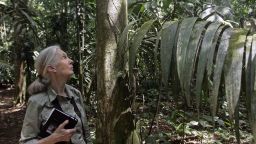Story highlights
Researchers at Oxford Brookes University discovered the dwarf galago due to its distinctive sounds
The new find's habitat deep in the Kumbira forest, Angola is under threat from logging and other human activity
Deep in the Angolan jungle, scientists have discovered a new species of primate thanks to its booming voice.
But any elation has been short lived for the team behind the find, as the animal is in immediate peril due to the destruction of its habitat.
The size of a squirrel (around six inches long without the tail), the Angolan dwarf galago is a kind of bushbaby, a small primate family scattered all over sub-Saharan Africa. However, most bushbabies are even smaller, making this one a giant among its tiny family.
Scientists at the Nocturnal Primate Research Group at Oxford Brookes University, UK found the dwarf galago thanks to its distinctive call — a loud, chirping crescendo of longer notes, followed by a fading twitter, used to attract mates and scare rivals away.
Armed with night vision flashlights, cameras and audio recorders, the team of researchers scoured the misty Kumbira Forest in northwestern Angola under the cover of dark, breathlessly listening for sounds of the nocturnal galagos, a distant cousins of the great apes and humans.
“We follow them at night, and whenever they make their calls we record them,” says Magdalena Svensson, one of the primate researchers on the trip.
“They get used to you. Within an hour they don’t run away anymore. We also use red light beams which don’t disturb them,” Svensson adds.
Experts in the acoustics of primates, the team were able to ascertain that this one was unique.
“We’ve got a big sound library, which is how we were able to identify anything that’s different, says Simon Bearder, professor emeritus in anthropology, Oxford Brookes University and president of the Primate Society of Great Britain.
“Each species has its characteristic set of calls, so if you hear different calls, you know it’s something new,” adds Bearder, a sub-Saharan field work veteran of more than forty years.
“The forest is very noisy at night, with all the frogs and insects calling at the same time, but we were able to pick out the bushbabies and record their sounds, which we then add to the collection,” says Svensson.
The dwarf galago also has a distinctive appearance with a longer face than other galagos, which the team identified using a photo library.
The discovery was announced in the American Journal of Physical Anthropology in February 2017.
“This new galago species is a very exciting discovery,” Russell Mittermeier of Conservation International said in a statement. “It is only the fifth new primate from the African mainland to be described since 2000, and only the second species of galago. What is more, it is from Angola, where there has been very little primate research to date.”
Globally it was not the only primate discovery announced this year, however. The Skywalker hoolock gibbon – named after the Star Wars character Luke Skywalker – made waves in January after its discovery in eastern Myanmar and southwestern China was announced in the American Journal of Primatology.
The new Angolan species was named galagoides kumbirensis, after the Kumbira forest where it was first observed, a key area of the Angolan Central Escarpment Forest which is under threat from human activities.
The researchers hope it will draw attention to the threats facing species in Kumbira — a forest reserve known for its bird and plant diversity and with several endemic species, such as the red crested turaco, which can be seen spreading its extravagant green and red plumage among the treetops. Its botanical diversity has dazzled scientists too, and they have called for more rigorous conservation efforts in the area.
Increased logging and agricultural activity is contributing to habitat loss, the researchers say. “Wherever we went, we met logging trucks,” says Svensson.
The domestic pet and bushmeat trade takes its toll on populations, according to the researcher. “Some of the bush babies — there are four different kinds — are being sold in the markets for meat,” she adds.
Charcoal production and agriculture is also changing the landscape.
“There is no question that the tree cover has declined,” says Matthew Hansen, professor of Geology at the University of Maryland, who analyzes satellite data to ascertain global forest loss. The Kumbira forest lost more than 5% of its tree cover between 2001 and 2014, according to their latest data set.
“In the center and north of the country, most of the protected areas have forest disturbance in them,” says Hansen.
It’s not just Angola that’s losing trees, he says. Other places such as Mozambique and the Democratic Republic of Congo are seeing a decline too.
“In Africa in general, the rate of forest disturbance goes up over time, due to increasing population and large-scale resource extraction,” says Hansen.
This is likely to continue, unless action to protect the forests is taken, he adds.
“Without a coherent land-use strategy, and some areas of the environment being off limits, we will see increasing rates, only slowed down by the end of the resources.”
The primate researchers counted 36 individuals during their trip in 2013, at three sites in northwest Angola; the Kumbira forest, Bimbe and the Northern Scarp Forest. While the total population is still unknown, the team has recommended that it be added to the IUCN list of vulnerable species.
They hope to return soon and continue their studies in Kumbira, hopefully to establish just how threatened this bushbaby is, and perhaps discover other unknown creatures hiding in the treetops.
“It is worrying that a species we’ve only just discovered could well disappear within the next few years,” Svensson adds. “It might have gone completely unnoticed.”














